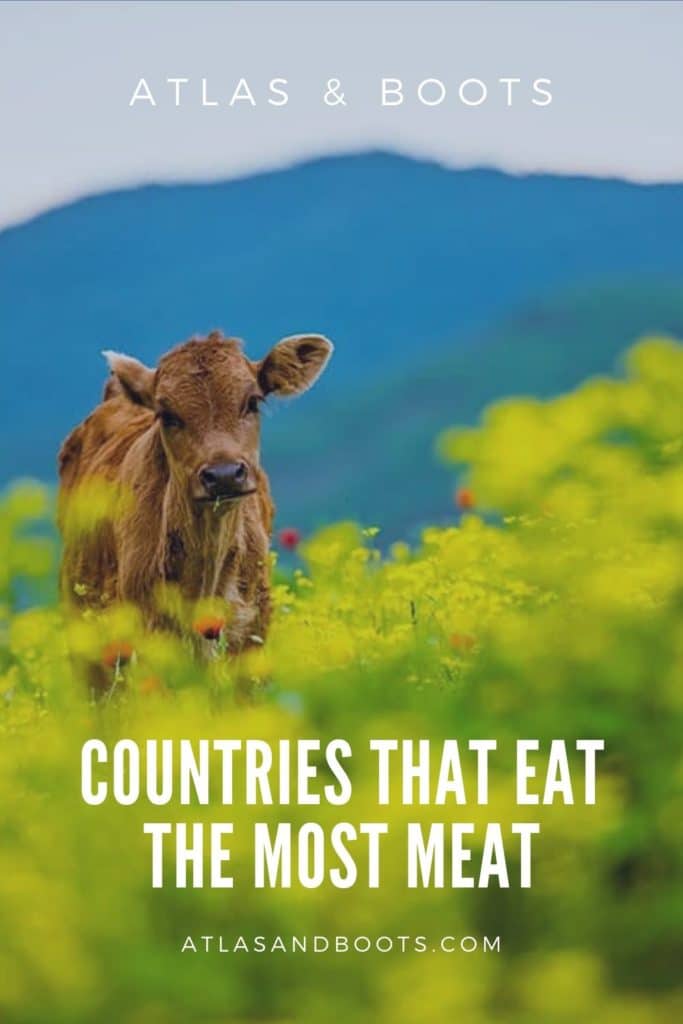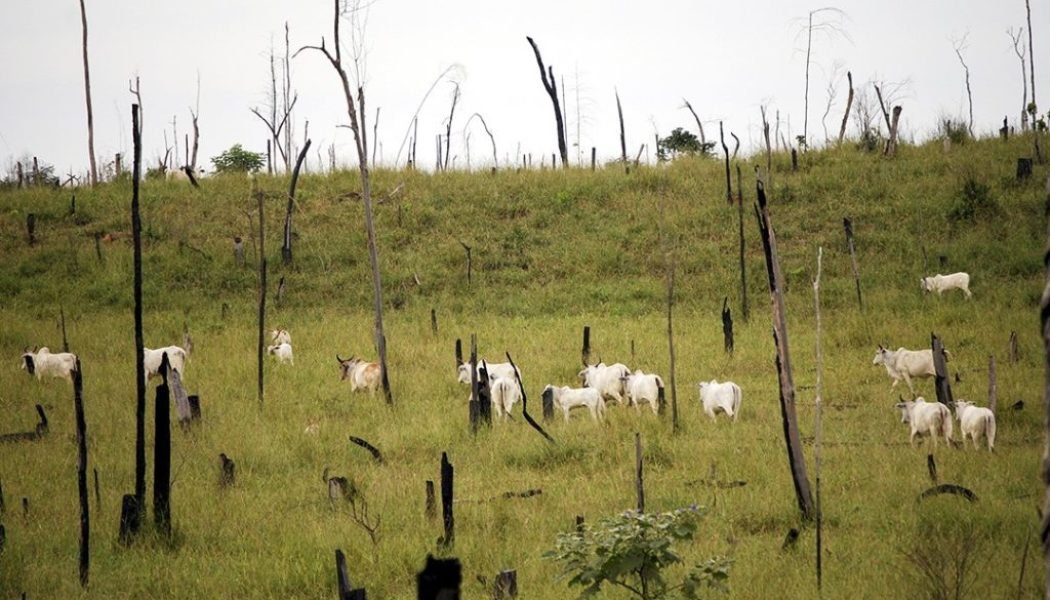The countries that eat the most meat are causing significant damage to the planet. It’s time to take responsibility and change the habits of a lifetime
There is very little left to debate on the subject. Simply put, the world must reduce the amount of meat it eats. In 2011, the world population reached seven billion and it’s now around 8.1 billion.
Despite some signs the global population growth rate is slowing, the world’s total population continues to skyrocket. As things stand, the planet simply cannot support the current levels of meat consumption.
Now, I am neither vegetarian nor vegan. However, it has quickly become clear that I – along with the rest of the global population – must change the habits of a lifetime and move towards a more plant-based diet.
A recent BBC analysis suggests that the use of land for growing food and forestry accounts for around 25% of all global greenhouse gas emissions. That is essentially the same as from electricity and heating, and considerably more than from all the trains, planes and automobiles on the planet.
When you look more closely at the food sector’s environmental impact, you can see that meat and dairy are the major factors. Worldwide, livestock accounts for between 14.5 and 18% of human-induced greenhouse gas emissions. When it comes to other warming gases, agriculture is one of the leading contributors to both methane and nitrous oxide emissions.
Matt McGrath, BBC Environment correspondent
Livestock uses 83% of farmland and produces 60% of agriculture’s greenhouse gas emissions. Yet, it provides just 18% of the food calories and 37% of protein required by humans.
The maths is strikingly simple: eating meat makes little economic sense.
The arguments for reducing meat
In 2018, scientists behind the most comprehensive analysis of its kind announced that avoiding meat and dairy products is the single biggest way to reduce your environmental impact on the planet.
In 2019, a group of 37 scientists developed the planetary health diet, a ‘flexitarian’ and healthy diet founded on a sustainable food system. It requires a massive shift away from meat, particularly red which must be cut by half.
Reducing meat in our diets would drastically reduce greenhouse gas emissions, help to prevent species from going extinct, stop the expansion of farmland and preserve water. The change in diet would prevent the collapse of the natural world that all humanity depends on.
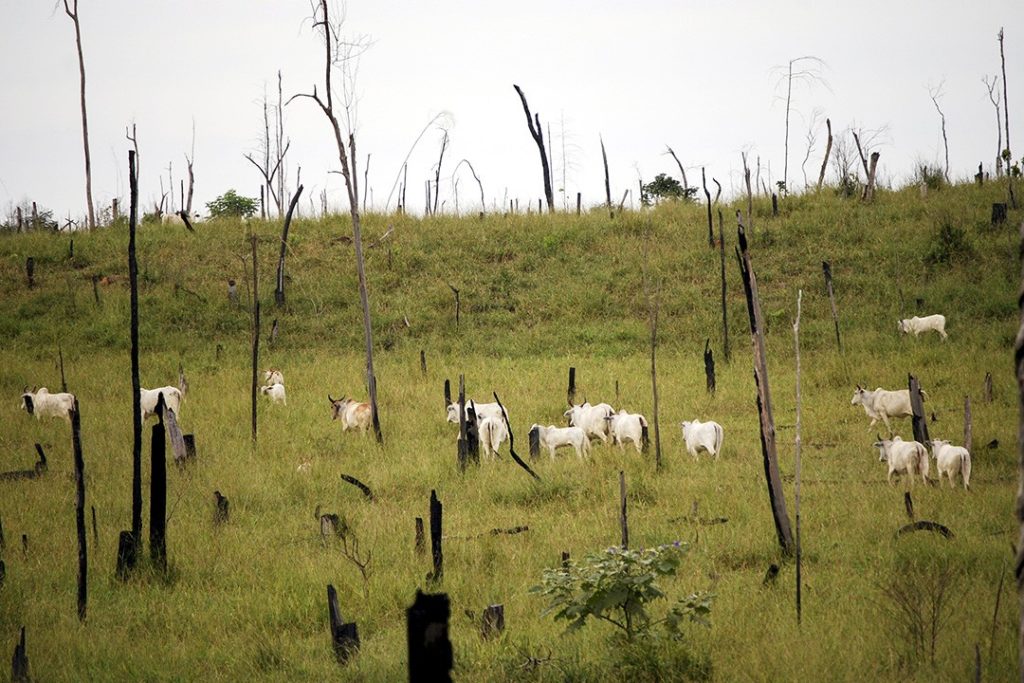
Further to the environmental argument is the debate around the ethical treatment of animals. The pain and suffering animals in the livestock industry endure is well documented. Historian, philosopher and bestselling author Yuval Noah Harari has suggested that industrial farming is one of the worst crimes in history.
Every year, in the UK alone, approximately 2.6 million cattle, 10 million pigs, 14.5 million sheep and lambs, 80 million fish and 950 million birds are slaughtered for human consumption. As the artificial meat industry advances, the final argument for farming animals is collapsing.
The suffering that is inherent in the production of meat can no longer be defended. Livestock farming will almost certainly be one of the things that future generations look back on as horrific, primitive and shameful.
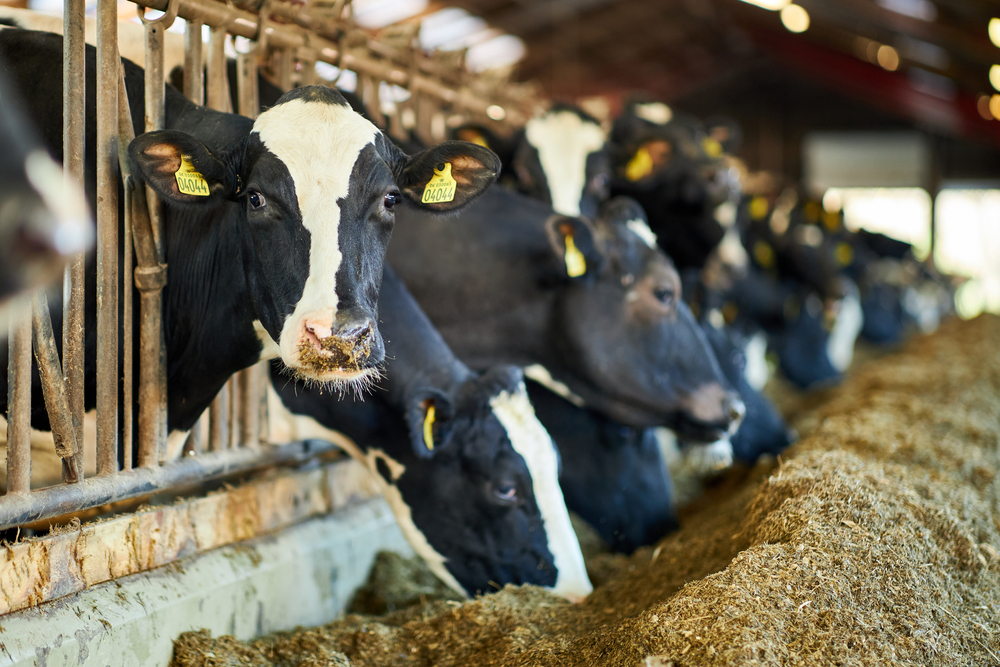
We’ve written before about how the world is not necessarily getting better. Basic education, literacy, democracy and vaccination may all be improving for humans, but for everything else – the millions of species that also call Earth their home – the world is getting worse.
Finally, there are health benefits of moving towards a flexitarian diet. Reducing meat in our diets will also lead to reducing diet-related diseases such as heart attacks, strokes and certain types of cancer. These are now the biggest killers in developed countries around the world.
who eats the most meat?
A report, prepared by 107 scientists for the UN’s Intergovernmental Panel on Climate Change (IPCC), says the West’s high consumption of meat and dairy produce is fuelling global warming.
The report, analysed by the BBC, says that switching to a more plant-based diet will help fight climate change. It also stresses that more people could be fed using less land if individuals cut down on their meat consumption.
“We’re not telling people to stop eating meat. In some places people have no other choice. But it’s obvious that in the West we’re eating far too much”.
Prof Pete Smith, Aberdeen University, UK
The responsibility for global meat reduction falls overwhelmingly on the shoulders of the world’s richer countries. When we compare consumption across different countries, typically, the richer the country or territory is, the more meat it consumes.
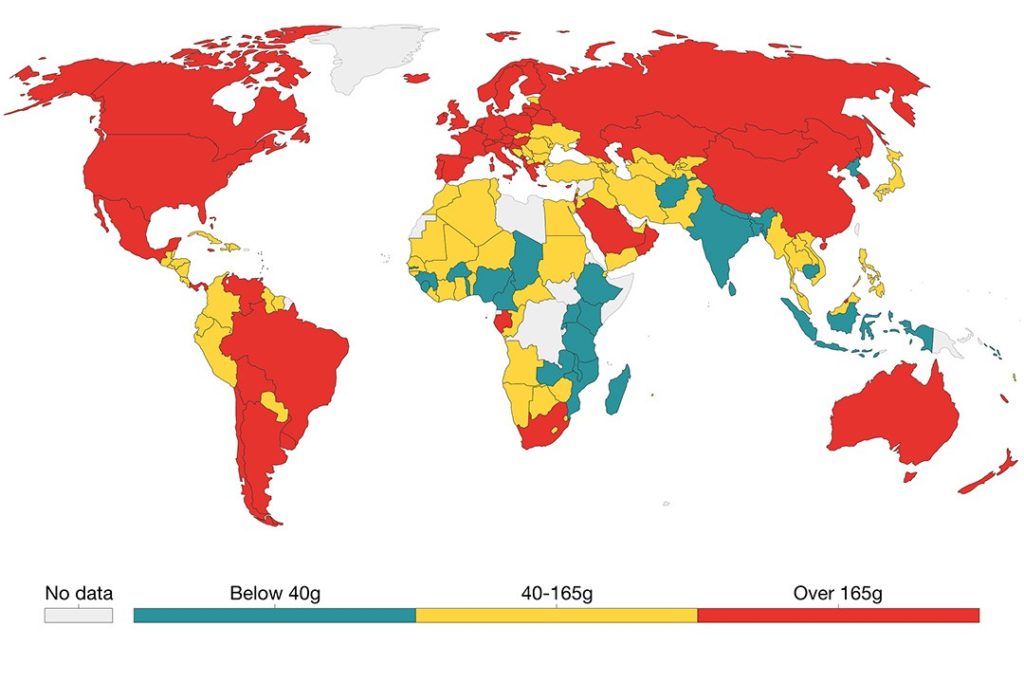
It is not down to the size of a country’s population, but how rich that population is. The more money we have, the more meat we eat. For those in low-income countries, meat is still very much a luxury.
The countries that eat the most meat are the ones causing the most damage to the planet. It’s time for those of us who live in these countries to take responsibility and change our eating habits.
Countries with the lowest & highest meat consumption
The below table shows the countries with the highest average daily meat consumption and the lowest – or the most vegetarian countries in the world – measured in grams per person per day.
Least meat-consuming countries
- India, 10.10
- Bangladesh, 11.3
- Gambia, 17.6
- Sri Lanka, 17.8
- Ethiopia, 19.3
- Rwanda, 22.0
- Mozambique, 23.3
- Nigeria, 25.2
- Tanzania, 27.4
- Guinea, 28.5
Most meat-consuming countries
- Hong Kong SAR, China, 419.6
- Australia, 318.5
- USA, 315.5
- Argentina, 293.8
- Bahamas, 285.5
- Samoa, 280.0
- New Zealand, 277.8
- French Polynesia, 27.07
- St Lucia, 272.6
- Luxembourg, 270.0
Countries that eat the most meat – ranked
The data below is from Our World in Data and ranks the average daily meat consumption of 173 countries or territories, measured in grams per person per day. The data is from 2013, the most recent available.
| Rank | Country | Grams |
|---|---|---|
| 1 | Hong Kong SAR, China | 419.6 |
| 2 | Australia | 318.5 |
| 3 | United States | 315.5 |
| 4 | Argentina | 293.8 |
| 5 | Bahamas | 285.5 |
| 6 | Samoa | 280.0 |
| 7 | New Zealand | 277.8 |
| 8 | French Polynesia | 27.07 |
| 9 | St Lucia | 272.6 |
| 10 | Luxembourg | 270.0 |
| 11 | Brazil | 267.4 |
| 12 | Bermuda | 265.7 |
| 13 | St Vincent & Grenadines | 261.8 |
| 14 | Israel | 260.7 |
| 15 | Spain | 257.7 |
| 16 | Iceland | 255.7 |
| 17 | Austria | 249.0 |
| 18 | Canada | 248.7 |
| 19 | Netherlands | 245.2 |
| 20 | Belarus | 244.1 |
| 21 | Portugal | 242.1 |
| 22 | France | 237.7 |
| 23 | Ireland | 237.5 |
| 24 | Malta | 237.3 |
| 25 | Brunei | 235.6 |
| 26 | Germany | 235.5 |
| 27 | Chile | 234.8 |
| 28 | Antigua & Barbuda | 233.1 |
| 29 | Montenegro | 231.6 |
| 30 | Italy | 230.3 |
| 31 | Kuwait | 227.1 |
| 32 | New Caledonia | 225.7 |
| 33 | Uruguay | 225.5 |
| 34 | Denmark | 224.3 |
| 35 | Sweden | 223.5 |
| 36 | United Kingdom | 223.3 |
| 37 | Mongolia | 222.2 |
| 38 | St Kitts & Nevis | 216.7 |
| 39 | Taiwan | 212.9 |
| 40 | Lithuania | 212.8 |
| 41 | Finland | 212.4 |
| 42 | Greece | 209.9 |
| 43 | Trinidad & Tobago | 209.1 |
| 44 | Poland | 208.5 |
| 45 | Cyprus | 207.1 |
| 46 | Russia | 205.0 |
| 47 | Czech Rep | 199.6 |
| 48 | Venezuela | 199.4 |
| 49 | Switzerland | 198.2 |
| 50 | Slovenia | 195.6 |
| 51 | Norway | 194.2 |
| 52 | Gabon | 194.0 |
| 53 | Belgium | 191.6 |
| 54 | Barbados | 186.7 |
| 55 | Kazakhstan | 185.9 |
| 56 | Panama | 181.9 |
| 57 | Bolivia | 181.9 |
| 58 | Croatia | 181.7 |
| 59 | Hungary | 178.2 |
| 60 | South Africa | 177.9 |
| 61 | Saudi Arabia | 174.7 |
| 62 | South Korea | 174.3 |
| 63 | Mexico | 170.5 |
| 64 | Albania | 169.8 |
| 65 | Oman | 169.7 |
| 66 | China | 169.4 |
| 67 | Jamaica | 169.2 |
| 68 | Latvia | 167.4 |
| 70 | Grenada | 166.9 |
| 71 | UAE | 160.8 |
| 72 | Estonia | 160.4 |
| 73 | Turkmenistan | 156.4 |
| 74 | Malaysia | 154.1 |
| 75 | Suriname | 153.6 |
| 76 | Vietnam | 151.3 |
| 77 | Ukraine | 150.0 |
| 78 | Ecuador | 147.9 |
| 79 | Cuba | 147.8 |
| 80 | Slovakia | 147.6 |
| 81 | Bulgaria | 147.2 |
| 82 | Paraguay | 146.9 |
| 83 | Mauritius | 146.5 |
| 84 | Serbia | 146.1 |
| 85 | Dominica | 142.3 |
| 86 | Colombia | 139.2 |
| 87 | Belize | 138.3 |
| 88 | Costa Rica | 137.0 |
| 89 | Japan | 135.5 |
| 90 | Romania | 135.4 |
| 91 | Dominican Rep | 129.3 |
| 92 | Armenia | 125.3 |
| 93 | Jordan | 122.7 |
| 94 | Guyana | 120.0 |
| 95 | Vanuatu | 111.7 |
| 96 | Moldova | 109.2 |
| 97 | Lebanon | 108.6 |
| 98 | Fiji | 108.5 |
| 99 | Myanmar | 106.9 |
| 100 | Macedonia | 104.6 |
| 101 | Timor-Leste | 101.9 |
| 102 | Angola | 99.0 |
| 103 | Uzbekistan | 97.4 |
| 104 | Turkey | 96.2 |
| 105 | Philippines | 96.2 |
| 106 | Morocco | 96.0 |
| 107 | Tajikistan | 95.5 |
| 108 | Honduras | 93.2 |
| 109 | Iran | 90.1 |
| 110 | Maldives | 88.8 |
| 111 | Bosnia & Herzegovina | 88.3 |
| 112 | Kiribati | 88.2 |
| 113 | Kyrgyzstan | 87.9 |
| 114 | Azerbaijan | 85.2 |
| 115 | Egypt | 83.5 |
| 116 | Mauritania | 83.2 |
| 117 | Tunisia | 83.0 |
| 118 | Nicaragua | 81.8 |
| 119 | Central African Rep | 80.7 |
| 120 | Congo | 80.5 |
| 121 | Thailand | 80.4 |
| 122 | El Salvador | 79.6 |
| 123 | Botswana | 79.3 |
| 124 | Georgia | 76.7 |
| 125 | Guatemala | 75.1 |
| 126 | Sudan | 74.1 |
| 127 | Swaziland | 70.9 |
| 128 | Benin | 69.0 |
| 129 | Namibia | 68.4 |
| 130 | Mali | 67.8 |
| 131 | Lesotho | 67.4 |
| 132 | Peru | 61.7 |
| 133 | Algeria | 57.7 |
| 134 | Laos | 57.7 |
| 135 | Yemen | 56.0 |
| 136 | Iraq | 53.9 |
| 137 | Djibouti | 50.3 |
| 138 | Zimbabwe | 50.0 |
| 139 | Haiti | 49.3 |
| 140 | Ghana | 47.8 |
| 141 | Niger | 47.1 |
| 142 | Pakistan | 45.0 |
| 143 | Guinea-Bissau | 44.7 |
| 144 | Liberia | 44.7 |
| 145 | Sao Tome & Principe | 44.1 |
| 146 | Senegal | 43.2 |
| 147 | Cote d’Ivoire | 41.1 |
| 148 | Kenya | 39.2 |
| 149 | Madagascar | 38.7 |
| 150 | North Korea | 38.3 |
| 151 | Solomon Islands | 37.8 |
| 152 | Indonesia | 37.1 |
| 153 | Cameroon | 36.6 |
| 154 | Cambodia | 36.2 |
| 155 | Zambia | 35.7 |
| 156 | Afghanistan | 33.8 |
| 157 | Nepal | 33.5 |
| 158 | Togo | 33.2 |
| 159 | Uganda | 33.2 |
| 160 | Chad | 32.9 |
| 161 | Burkina Faso | 32.1 |
| 162 | Malawi | 30.8 |
| 163 | Sierra Leone | 29.3 |
| 164 | Guinea | 28.5 |
| 165 | Tanzania | 27.4 |
| 166 | Nigeria | 25.2 |
| 167 | Mozambique | 23.3 |
| 168 | Rwanda | 22.0 |
| 169 | Ethiopia | 19.3 |
| 170 | Sri Lanka | 17.8 |
| 171 | Gambia | 17.6 |
| 172 | Bangladesh | 11.3 |
| 173 | India | 10.1 |
Enjoyed this post? pin it for later…
